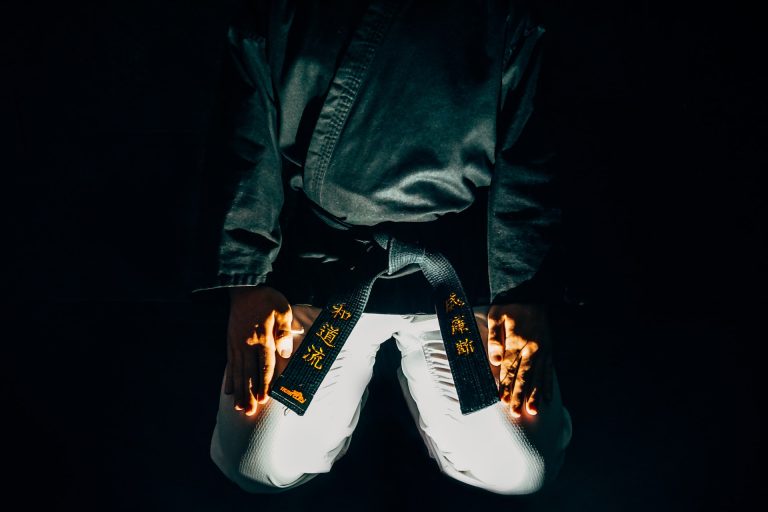How Do Karate Belts Rank? A Comprehensive Guide
Karate is a popular martial art that is practiced by people all over the world. It is a physical art form that involves various moves and techniques that help to improve the physical health of a person. One of the most important aspects of karate is the belt system, which is used to rank students according to their level of proficiency in the art form. In this blog post, we will take a deep dive into how karate belts rank, from the beginner white belt to the advanced black belt.
What is the Karate Belt System?
The karate belt system is a series of colored belts that represent a student’s level of proficiency in the martial art. There are different colors of belts, with each subsequent color representing a higher level of proficiency. The colors of belts follow the spectrum of the rainbow and they are, in order of proficiency, white, yellow, orange, green, blue, purple, brown, red, and black.
What is the Meaning of Each Belt Color?
Each belt color has a meaning, and this meaning differs depending on the school or style of karate that the student is practicing. However, there are some common meanings that are associated with each belt color. Here is a breakdown of what each belt color represents:
White Belt
The white belt is the starting point for all students who are learning karate. It represents purity, innocence, and a willingness to learn. During this stage, students are taught the basic techniques and moves of karate.
Yellow Belt
After achieving the white belt, the student will move on to the yellow belt, which represents the first stage of growth. During this stage, the student has gained some experience and knowledge of the basic techniques of karate. The yellow belt signifies a deeper understanding of the art form and the student’s progress towards mastering the techniques.
Orange Belt
The orange belt represents the second stage of growth. Students with an orange belt are considered to have a stronger foundation in karate and have developed a greater sense of discipline and focus. At this stage, students will have to begin practicing more demanding and advanced techniques.
Green Belt
After passing the orange belt, students will then progress to the green belt, which represents a continued growth and expansion of knowledge. At this stage, students will be expected to have more advanced techniques and will be challenged to push themselves even harder.
Blue Belt
The blue belt is the stage at which the student should have mastered the basics of karate and have a deep understanding of the techniques. Students are now ready to move on to more advanced techniques and will begin to understand how the different techniques can be combined.
Purple Belt
The purple belt is the stage where the students have gained deeper knowledge and understanding of karate. The student will have learned techniques that are more complicated, and their movements will be smoother and more precise.
Brown Belt
The brown belt is the stage where the student has achieved a high level of technical proficiency. At this level, the student will be expected to have mastered all of the different techniques and will be able to execute them with ease and precision.
Red Belt
The red belt is the final stage before the black belt, and students at this level demonstrate a deep understanding and mastery of karate techniques. The red belt is the stage where the student’s physical and mental abilities are pushed to their limits.
Black Belt
The black belt is the final stage of the karate belt system and represents the highest level of proficiency. At this level, the student has gained mastery over karate techniques and has a deep understanding of the art form. Achieving a black belt is a major accomplishment, and it requires years of dedicated practice and training.
How are Belts Awarded?
In order to earn a belt, the student must demonstrate proficiency in the techniques and principles of karate. Belt tests are conducted periodically, and students are evaluated based on their knowledge, skill, proficiency, and character. The structure of the exam varies depending on the level of the student’s belt. Promotion to higher belts is determined by the student’s performance on the exam, as well as their attendance, attitude, and overall progress in the martial art.
How Do Karate Belts Rank – Answering Commonly Asked Questions
Karate has a unique ranking system that uses different colored belts to indicate a student’s progress and skill level. This ranking system can be confusing for beginners, and we receive a lot of questions about how karate belts rank. In this post, we aim to answer some of the most common questions we receive about the karate belt ranking system.
1) How many belt colors are there in karate?
Karate has a ranking system that consists of ten belt colors, starting from white for beginners and progressing to black for experts. The belt colors are as follows:
– White belt
– Yellow belt
– Orange belt
– Green belt
– Blue belt
– Purple belt
– Brown belt
– Red belt
– Black belt (Dan ranks)
2) How long does it take to progress through the ranks?
The time it takes to progress through the ranks depends on the individual student’s dedication, effort, and skill level. Typically, it takes two to four years to move from a white to a black belt, but this can vary significantly. Some schools have specific time requirements for each belt, while others base advancement on individual progress and skill level.
3) How do I earn a new belt?
To earn a new belt, a student must demonstrate proficiency in the techniques, forms, and principles required for that belt’s rank. Each school and organization may have slightly different requirements, but most karate schools require a student to pass a belt test. The test will often include demonstrating techniques, forms, board breaking, sparring, and answering theory questions.
4) What is the highest rank in karate?
The highest rank in karate is the 10th Dan black belt. This is an honorary rank reserved for exceptional martial artists who have dedicated their lives to karate and made significant contributions to the art. It can take several decades of training and teaching to achieve this rank, and it is not necessary for most students to reach this level.
5) What do the different belt colors represent?
Each belt color represents the student’s proficiency level and knowledge of karate. White is the starting level, indicating a beginner with a basic understanding of karate. As a student progresses through the ranks, they will learn more advanced techniques, forms, and principles, and their belt color will change to reflect their increasing knowledge and skill.
6) Can I skip some of the lower belts and go straight to a higher rank?
It is possible to skip some of the lower belts and go straight to a higher rank, but it is relatively rare. Most schools require students to progress through each belt in sequence, demonstrating proficiency at each level before moving on to the next. However, some schools may allow students to take a test to skip a belt rank if they demonstrate exceptional skill and knowledge.
7) How important is the belt ranking system in karate?
While belt ranking can be an essential motivator for some students, it is not the most crucial factor in learning karate. The belt system is designed to help students set goals and track their progress but is by no means the only indicator of a student’s ability or skill level. Working hard, showing dedication and determination, and continuously improving one’s skills are more critical than the color of the belt.
How Do Karate Belts Rank: A Comprehensive Guide
If you’re a fan of martial arts or are interested in starting a karate program, you’ve probably heard about karate belt rankings. Karate belts symbolize the different stages of a karate practitioner’s development and serve as markers of progress and accomplishment. In this blog post, we’ll discuss everything you need to know about karate belt rankings, including what you can expect to learn at each level and how to advance to the next belt rank.
Understanding the Belt Ranking System in Karate
Before we dive deep into the karate belt ranking system, it’s important to understand the philosophy behind it. Karate is a discipline that emphasizes the pursuit of knowledge and mastery, with each belt rank serving as a milestone towards that goal. In traditional karate systems, there are ten belts or grades ranking from white to black, with additional higher degrees within the black belt rank.
The Belt Color System and What They Mean
The different colors of a karate belt signify different levels of proficiency, knowledge, and experience. Here is a summary of the common belt rankings and what they represent:
White Belt
The white belt represents a beginner’s level in karate. It signifies the start of the journey towards mastery, reflecting innocence and a willingness to learn.
Yellow Belt
The yellow karate belt signifies the first step towards technical proficiency in karate. At this stage, students are expected to have gained fundamental knowledge about karate techniques and principles.
Orange Belt
The orange karate belt is awarded to students who have demonstrated proficiency in basic techniques, including footwork, strikes, and blocks.
Green Belt
The green karate belt is awarded to students who have shown proficiency in complex techniques and effective execution of katas or forms.
Blue Belt
The blue karate belt represents the development of control, discipline, and focus in karate. At this stage, students are expected to apply their knowledge of techniques and principles to more advanced scenarios.
Purple Belt
The purple karate belt signifies knowledge and experience in the art of karate. At this level, students are encouraged to expand their understanding of karate beyond the physical aspect and into the mental and spiritual dimensions of the art.
Brown Belt
The brown karate belt represents a high level of proficiency and knowledge in karate. At this stage, students should have mastered all the basic techniques and principles of karate and be able to apply them fluently.
Black Belt
The black karate belt represents the highest level of proficiency and knowledge in karate. It signifies mastery of not only the physical aspect of karate but also the mental and spiritual dimensions. Within the black belt rank, there are several levels or degrees representing the mastery of more advanced techniques and principles.
How to Advance in Karate Belt Ranks
Advancing from one karate belt rank to another requires hard work, discipline, and dedication. Here are some tips to help you advance in karate belt ranks:
Set Attainable Goals
Set realistic goals for your karate training and strive to achieve them. Keep in mind that achieving small goals leads to progress and development.
Practice Consistently
Consistency is key in karate training. Practice regularly, both in and out of class, to develop muscle memory and technique fluency.
Focus on Technique
Don’t rush to advance in karate belt ranks; instead, focus on mastering the techniques and principles at your current level. This will lay a stable foundation for your future progress.
Stay Committed
Karate belt ranks require dedication and commitment. Set aside time for training, and don’t let distractions deter you from your goal.
Conclusion
Karate belt ranks represent progress, discipline, and dedication towards the pursuit of knowledge and mastery in karate. By understanding the different levels of proficiency and knowledge represented by each belt color, you can set realistic goals for your progress in karate training. Remember, advancing in karate belt ranks requires hard work, discipline, and focus. Stay committed to your training, and you will progress towards mastery.
Inhaltsverzeichnis






